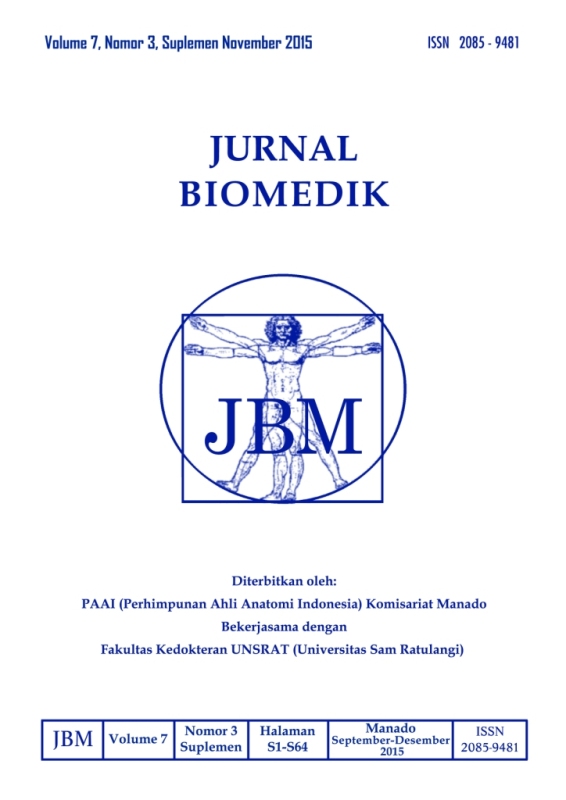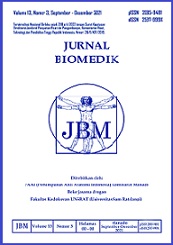SUBCORNEAL PUSTULAR DERMATOSIS IN A 47-YEAR-OLD WOMAN
DOI:
https://doi.org/10.35790/jbm.7.3.2015.10442Abstract
Abstrak: Subcorneal pustular dermatosis (SPD) adalah penyakit inflamasi kulit yang jarang dan kronik-rekuren. Penyakit ini umumnya didapatkan pada wanita usia diatas 40 tahun dengan etiologi belum diketahui. Gambaran klinis yang khas berupa pustul atau vesikel yang dengan cepat berubah menjadi pustul di atas dasar kulit eritematosa, menyebar periferal, central healing, dan menyembuh meninggalkan area eritematosa berbentuk polisiklik disertai munculnya lesi baru. Lesi mengenai area intertriginosa, batang tubuh, dan daerah fleksural ekstremitas. Kami melaporkan kasus seorang perempuan usia 47 tahun dengan keluhan lepuh di hampir seluruh tubuh sejak setahun lalu. Lepuh mudah pecah dan meninggalkan erosi. Status dermatologis menunjukkan generalisata makula eritematosa et hiperpigmentasi, multipel, diskret, ukuran lentikular-plakat; vesikel multipel dan pustul di atasnya; dan pustul yang pecah dengan erosi dan krusta. Pada pasien dilakukan anamnesis, pemeriksaan laboratorium, serta biopsi kulit. Pemeriksaan Gram lepuh menunjukkan hanya terdapat leukosit PMN. Laboratorium darah lengkap normal, hitung eosinofil 1,9%, hitung limfosit 24,3%, LED 70 mm/jam, dan IgE total 831.000 IU/mL. Pemeriksaan histopatologik menunjukkan spongiosis, lepuh subkorneal berisi fibrin, neutrofil, sedikit eosinofil di epidermis. Pada dermis tampak superficial perivascular inflammatory infiltration (neutrofil, limfosit, sedikit eosinofil). Pada kasus ini, diagnosis ditegakkan berdasarkan anamnesis, pemeriksaan fisik, dan pemeriksaan histopatologik yang khas untuk SPD.
Kata kunci: subcorneal pustular dermatosis, pemeriksaan histopatologik
Abstract: Subcorneal pustular dermatosis (SPD) is a pustular eruption which is rare, chronic, and recurrent. This condition is commonly found in women over the age of 40 years with unknown etiology. It is characterized with symmetrical pustules/vesicles that quickly develop to pustules on erythematous skin with peripherally spreading. The pustules undergo central healing leaving polycyclic erythematous areas in which new pustules arise. The lesions typically involve the intertriginous areas, trunks, and flexor of limbs. We reported a case of a 47-year-old woman with blisters and pustules all of the body surface since a year ago. The blisters ruptured easily and became erosions. The dermatological status indicated generalized erythematous hyperpigmented macules which were multiple, discrete, lenticular-plaques in size, multiple vesicles with pustules on them, and ruptured pustules leaving erosions as well as crusted areas. Anamnesis, physical examination, laboratory examinations, and a skin biopsy were performed. The Gram staining of the blister showed only PMN leukocytes. There were a normal complete blood count, eosinophil count 1.9%, lymphocyte count 24.3%, elevated ESR 70 mm/hour, and the total IgE 831.000 IU/mL. The histopathological examination indicated spongiosis, subcorneal blister consisting of fibrin, neutrophils, and few eosinophils in the epidermis. The dermis revealed superficial perivascular inflammatory infiltration (neutrophils, lymphocytes, some eosinophils). These findings were typical for SPD. Conclusion: This case was diagnosed as subcorneal pustular dermatosis based on anamnesis, physical examination, and a histopathological examination.
Keywords: subcorneal pustular dermatosis, histopathological examination
Downloads
Issue
Section
License
Penyunting menerima sumbangan tulisan yang BELUM PERNAH diterbitkan dalam media lain. Naskah yang masuk dievaluasi dan disunting keseragaman format istilah dan cara penulisan sesuai dengan format penulisan yang terlampir dalam jurnal ini.
Segala isi dan permasalahan mengenai tulisan yang yang diterbitkan dalam jurnal menjadi tanggung jawab penuh dari penulis.







